Zichao Li
dots.llm1 Technical Report
Jun 06, 2025Abstract:Mixture of Experts (MoE) models have emerged as a promising paradigm for scaling language models efficiently by activating only a subset of parameters for each input token. In this report, we present dots.llm1, a large-scale MoE model that activates 14B parameters out of a total of 142B parameters, delivering performance on par with state-of-the-art models while reducing training and inference costs. Leveraging our meticulously crafted and efficient data processing pipeline, dots.llm1 achieves performance comparable to Qwen2.5-72B after pretraining on 11.2T high-quality tokens and post-training to fully unlock its capabilities. Notably, no synthetic data is used during pretraining. To foster further research, we open-source intermediate training checkpoints at every one trillion tokens, providing valuable insights into the learning dynamics of large language models.
Collaborative Memory: Multi-User Memory Sharing in LLM Agents with Dynamic Access Control
May 23, 2025Abstract:Complex tasks are increasingly delegated to ensembles of specialized LLM-based agents that reason, communicate, and coordinate actions-both among themselves and through interactions with external tools, APIs, and databases. While persistent memory has been shown to enhance single-agent performance, most approaches assume a monolithic, single-user context-overlooking the benefits and challenges of knowledge transfer across users under dynamic, asymmetric permissions. We introduce Collaborative Memory, a framework for multi-user, multi-agent environments with asymmetric, time-evolving access controls encoded as bipartite graphs linking users, agents, and resources. Our system maintains two memory tiers: (1) private memory-private fragments visible only to their originating user; and (2) shared memory-selectively shared fragments. Each fragment carries immutable provenance attributes (contributing agents, accessed resources, and timestamps) to support retrospective permission checks. Granular read policies enforce current user-agent-resource constraints and project existing memory fragments into filtered transformed views. Write policies determine fragment retention and sharing, applying context-aware transformations to update the memory. Both policies may be designed conditioned on system, agent, and user-level information. Our framework enables safe, efficient, and interpretable cross-user knowledge sharing, with provable adherence to asymmetric, time-varying policies and full auditability of memory operations.
The Devil Is in the Details: Tackling Unimodal Spurious Correlations for Generalizable Multimodal Reward Models
Mar 05, 2025Abstract:Multimodal Reward Models (MM-RMs) are crucial for aligning Large Language Models (LLMs) with human preferences, particularly as LLMs increasingly interact with multimodal data. However, we find that MM-RMs trained on existing datasets often struggle to generalize to out-of-distribution data due to their reliance on unimodal spurious correlations, primarily text-only shortcuts within the training distribution, which prevents them from leveraging true multimodal reward functions. To address this, we introduce a Shortcut-aware MM-RM learning algorithm that mitigates this issue by dynamically reweighting training samples, shifting the distribution toward better multimodal understanding, and reducing dependence on unimodal spurious correlations. Our experiments demonstrate significant improvements in generalization, downstream task performance, and scalability, establishing a more robust framework for multimodal reward modeling.
Cheems: A Practical Guidance for Building and Evaluating Chinese Reward Models from Scratch
Feb 24, 2025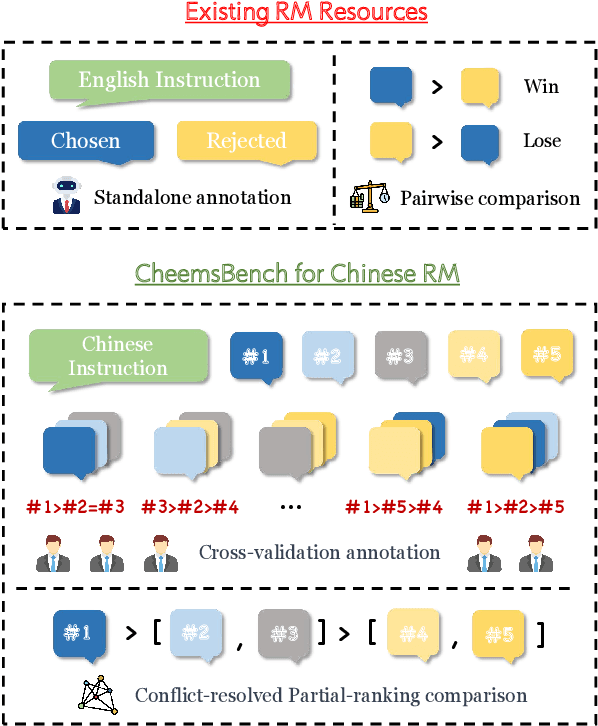

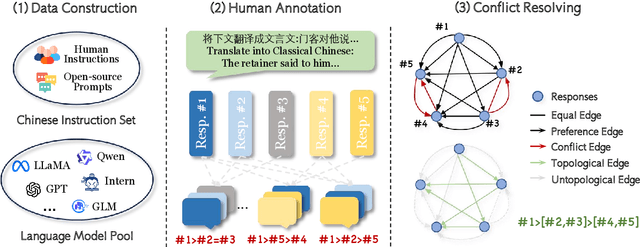
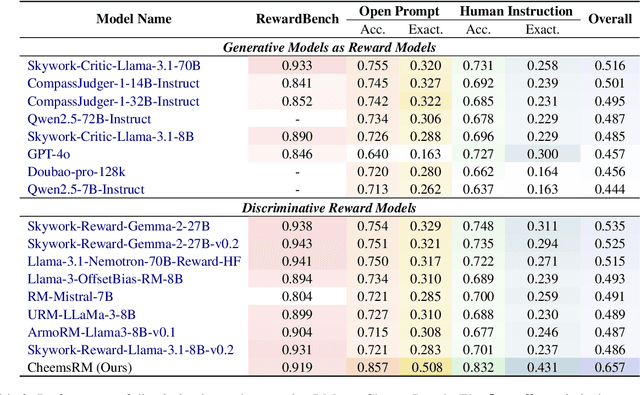
Abstract:Reward models (RMs) are crucial for aligning large language models (LLMs) with human preferences. However, most RM research is centered on English and relies heavily on synthetic resources, which leads to limited and less reliable datasets and benchmarks for Chinese. To address this gap, we introduce CheemsBench, a fully human-annotated RM evaluation benchmark within Chinese contexts, and CheemsPreference, a large-scale and diverse preference dataset annotated through human-machine collaboration to support Chinese RM training. We systematically evaluate open-source discriminative and generative RMs on CheemsBench and observe significant limitations in their ability to capture human preferences in Chinese scenarios. Additionally, based on CheemsPreference, we construct an RM that achieves state-of-the-art performance on CheemsBench, demonstrating the necessity of human supervision in RM training. Our findings reveal that scaled AI-generated data struggles to fully capture human preferences, emphasizing the importance of high-quality human supervision in RM development.
ReTreever: Tree-based Coarse-to-Fine Representations for Retrieval
Feb 11, 2025Abstract:Document retrieval is a core component of question-answering systems, as it enables conditioning answer generation on new and large-scale corpora. While effective, the standard practice of encoding documents into high-dimensional embeddings for similarity search entails large memory and compute footprints, and also makes it hard to inspect the inner workings of the system. In this paper, we propose a tree-based method for organizing and representing reference documents at various granular levels, which offers the flexibility to balance cost and utility, and eases the inspection of the corpus content and retrieval operations. Our method, called ReTreever, jointly learns a routing function per internal node of a binary tree such that query and reference documents are assigned to similar tree branches, hence directly optimizing for retrieval performance. Our evaluations show that ReTreever generally preserves full representation accuracy. Its hierarchical structure further provides strong coarse representations and enhances transparency by indirectly learning meaningful semantic groupings. Among hierarchical retrieval methods, ReTreever achieves the best retrieval accuracy at the lowest latency, proving that this family of techniques can be viable in practical applications.
BigDocs: An Open and Permissively-Licensed Dataset for Training Multimodal Models on Document and Code Tasks
Dec 05, 2024



Abstract:Multimodal AI has the potential to significantly enhance document-understanding tasks, such as processing receipts, understanding workflows, extracting data from documents, and summarizing reports. Code generation tasks that require long-structured outputs can also be enhanced by multimodality. Despite this, their use in commercial applications is often limited due to limited access to training data and restrictive licensing, which hinders open access. To address these limitations, we introduce BigDocs-7.5M, a high-quality, open-access dataset comprising 7.5 million multimodal documents across 30 tasks. We use an efficient data curation process to ensure our data is high-quality and license-permissive. Our process emphasizes accountability, responsibility, and transparency through filtering rules, traceable metadata, and careful content analysis. Additionally, we introduce BigDocs-Bench, a benchmark suite with 10 novel tasks where we create datasets that reflect real-world use cases involving reasoning over Graphical User Interfaces (GUI) and code generation from images. Our experiments show that training with BigDocs-Bench improves average performance up to 25.8% over closed-source GPT-4o in document reasoning and structured output tasks such as Screenshot2HTML or Image2Latex generation. Finally, human evaluations showed a preference for outputs from models trained on BigDocs over GPT-4o. This suggests that BigDocs can help both academics and the open-source community utilize and improve AI tools to enhance multimodal capabilities and document reasoning. The project is hosted at https://bigdocs.github.io .
From Isolated Conversations to Hierarchical Schemas: Dynamic Tree Memory Representation for LLMs
Oct 17, 2024



Abstract:Recent advancements in large language models have significantly improved their context windows, yet challenges in effective long-term memory management remain. We introduce MemTree, an algorithm that leverages a dynamic, tree-structured memory representation to optimize the organization, retrieval, and integration of information, akin to human cognitive schemas. MemTree organizes memory hierarchically, with each node encapsulating aggregated textual content, corresponding semantic embeddings, and varying abstraction levels across the tree's depths. Our algorithm dynamically adapts this memory structure by computing and comparing semantic embeddings of new and existing information to enrich the model's context-awareness. This approach allows MemTree to handle complex reasoning and extended interactions more effectively than traditional memory augmentation methods, which often rely on flat lookup tables. Evaluations on benchmarks for multi-turn dialogue understanding and document question answering show that MemTree significantly enhances performance in scenarios that demand structured memory management.
Seg2Act: Global Context-aware Action Generation for Document Logical Structuring
Oct 09, 2024



Abstract:Document logical structuring aims to extract the underlying hierarchical structure of documents, which is crucial for document intelligence. Traditional approaches often fall short in handling the complexity and the variability of lengthy documents. To address these issues, we introduce Seg2Act, an end-to-end, generation-based method for document logical structuring, revisiting logical structure extraction as an action generation task. Specifically, given the text segments of a document, Seg2Act iteratively generates the action sequence via a global context-aware generative model, and simultaneously updates its global context and current logical structure based on the generated actions. Experiments on ChCatExt and HierDoc datasets demonstrate the superior performance of Seg2Act in both supervised and transfer learning settings.
READoc: A Unified Benchmark for Realistic Document Structured Extraction
Sep 08, 2024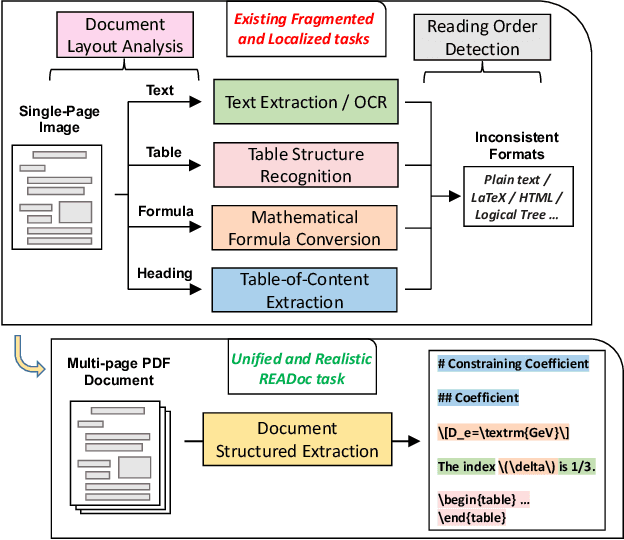



Abstract:Document Structured Extraction (DSE) aims to extract structured content from raw documents. Despite the emergence of numerous DSE systems, their unified evaluation remains inadequate, significantly hindering the field's advancement. This problem is largely attributed to existing benchmark paradigms, which exhibit fragmented and localized characteristics. To address these limitations and offer a thorough evaluation of DSE systems, we introduce a novel benchmark named READoc, which defines DSE as a realistic task of converting unstructured PDFs into semantically rich Markdown. The READoc dataset is derived from 2,233 diverse and real-world documents from arXiv and GitHub. In addition, we develop a DSE Evaluation S$^3$uite comprising Standardization, Segmentation and Scoring modules, to conduct a unified evaluation of state-of-the-art DSE approaches. By evaluating a range of pipeline tools, expert visual models, and general VLMs, we identify the gap between current work and the unified, realistic DSE objective for the first time. We aspire that READoc will catalyze future research in DSE, fostering more comprehensive and practical solutions.
Research on Feature Extraction Data Processing System For MRI of Brain Diseases Based on Computer Deep Learning
Jun 23, 2024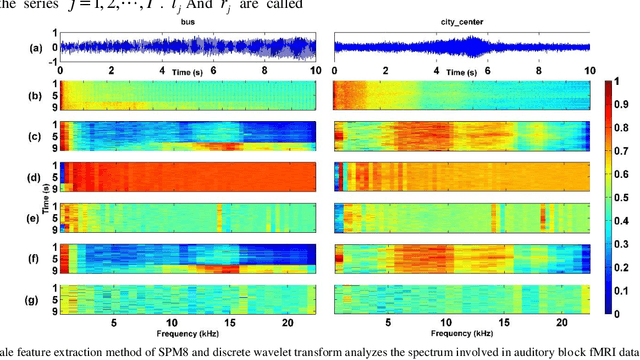
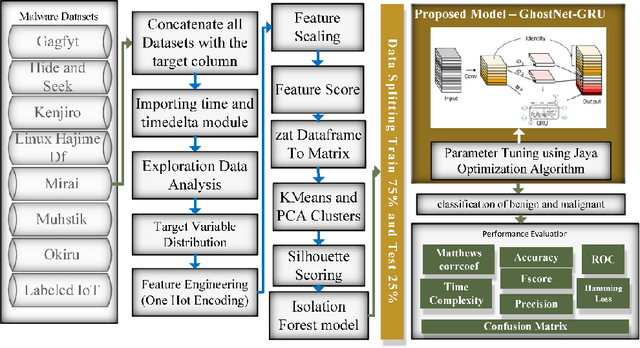
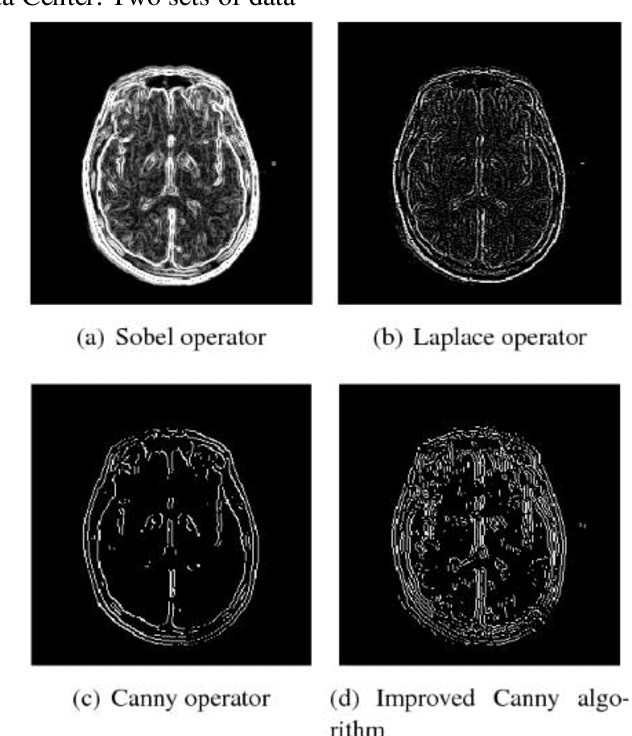
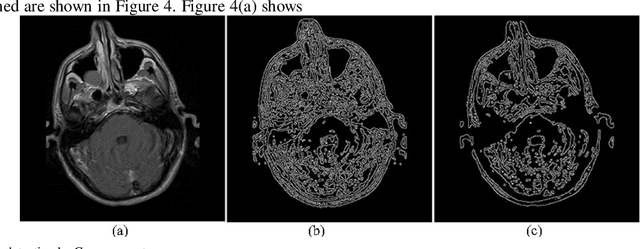
Abstract:Most of the existing wavelet image processing techniques are carried out in the form of single-scale reconstruction and multiple iterations. However, processing high-quality fMRI data presents problems such as mixed noise and excessive computation time. This project proposes the use of matrix operations by combining mixed noise elimination methods with wavelet analysis to replace traditional iterative algorithms. Functional magnetic resonance imaging (fMRI) of the auditory cortex of a single subject is analyzed and compared to the wavelet domain signal processing technology based on repeated times and the world's most influential SPM8. Experiments show that this algorithm is the fastest in computing time, and its detection effect is comparable to the traditional iterative algorithm. However, this has a higher practical value for the processing of FMRI data. In addition, the wavelet analysis method proposed signal processing to speed up the calculation rate.
 Add to Chrome
Add to Chrome Add to Firefox
Add to Firefox Add to Edge
Add to Edge